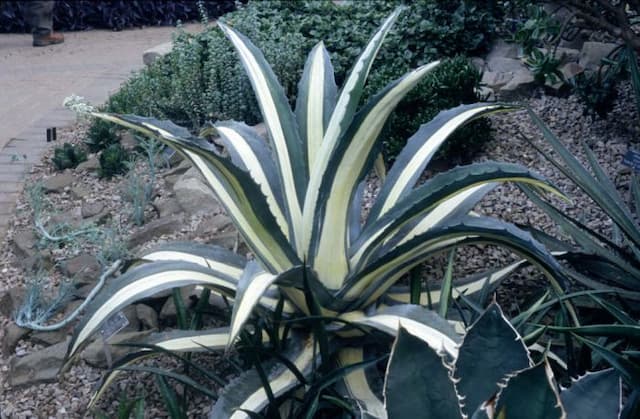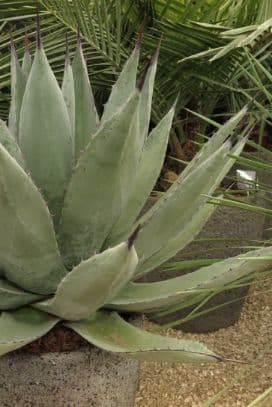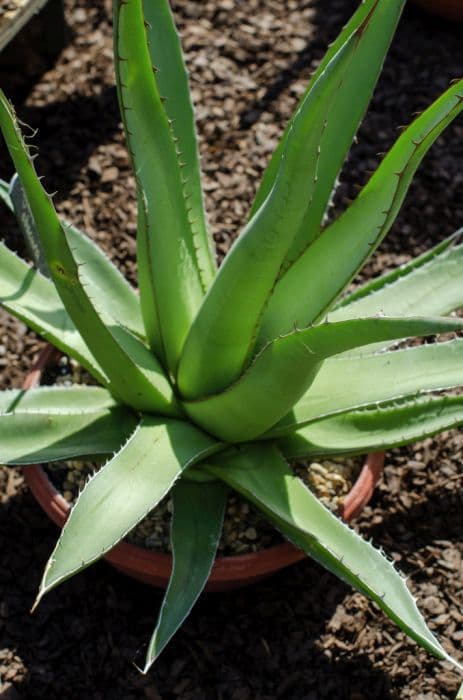Scilla liliohyacinthus 'Alba'

ABOUT
Scilla liliohyacinthus 'Alba', commonly known as white squill, presents itself with a strikingly graceful appearance. This bulbous perennial showcases lush green basal leaves which are typically strap-like and glossy in appearance. The most captivating aspect of the white squill is its flowers. It blooms in clusters, with each individual blossom resembling a small, delicate star. These flowers are pure white in color, offering an exquisite contrast against the green foliage. With the flowers arranged on a central stalk, the plant bears a resemblance to a loosely arranged spike or a raceme, which adds an upright element to its overall form. White squill also has a subtle beauty in the intricate details of its flowers, where each petal unfurls to reveal a soft, inviting allure that can be a highlight in a garden setting.
About this plant
 Names
NamesFamily
Asparagaceae.
Synonyms
White Pyrenean Lily, White Spanish Bluebell, White Amethyst.
Common names
Scilla liliohyacinthus.
 Toxicity
ToxicityTo humans
White squill is the common name of Scilla liliohyacinthus 'Alba'. This plant is considered to possess toxic properties, and humans should be cautious when handling or ingesting any part of it. If ingested, the toxic elements can cause symptoms such as nausea, vomiting, diarrhea, and abdominal pain. In severe cases, ingestion can lead to more significant health issues such as electrolyte imbalances, tremors, or cardiac arrhythmias. It is advisable for humans to avoid ingesting any part of the white squill plant and to seek medical attention if poisoning is suspected.
To pets
White squill is toxic to pets as well, including dogs and cats. The ingestion of any part of the plant can lead to signs of toxicity in animals which may include vomiting, diarrhea, drooling, lethargy, and abdominal pain. In more severe cases, it can cause increased heart rate, difficulty breathing, and incoordination. Veterinary attention should be sought immediately if a pet is suspected to have ingested any part of the white squill plant, as prompt treatment is crucial to manage and mitigate the effects of the toxicity.
 Characteristics
CharacteristicsLife cycle
Perennials
Foliage type
Deciduous
Color of leaves
Green
Flower color
White
Height
1-2 feet (30-60 cm)
Spread
0-1 feet (0-30 cm)
Plant type
Bulb
Hardiness zones
4
Native area
Europe
Benefits
 General Benefits
General Benefits- Aesthetic appeal: Scilla liliohyacinthus 'Alba', commonly known as White Pyrenean Squill, has attractive white blossoms that add visual interest to gardens and landscapes in spring.
- Pollinator attraction: Its flowers are known to attract bees and other pollinators, which are essential for the pollination of many plants and the health of ecosystems.
- Low maintenance: White Pyrenean Squill is considered relatively easy to care for, requiring minimal maintenance once established.
- Drought tolerance: Once established, it is relatively drought-tolerant, making it suitable for xeriscaping and gardens in drier climates.
- Naturalizing: It can spread and naturalize in suitable conditions, creating drifts of white flowers over time without the need for replanting.
- Seasonal interest: It provides early spring bloom, offering seasonal interest after the winter months when few other plants are flowering.
- Ground cover: Its foliage and spreading habit can help cover bare ground, reducing weed growth and soil erosion.
- Versatility in planting: It is suitable for a variety of planting situations, including rock gardens, borders, and underplanting for larger shrubs and trees.
 Medical Properties
Medical PropertiesThis plant is not used for medical purposes.
 Air-purifying Qualities
Air-purifying QualitiesThis plant is not specifically known for air purifying qualities.
 Other Uses
Other Uses- Scilla liliohyacinthus 'Alba', commonly known as white scilla, can be used in pressed flower crafts due to its attractive, star-shaped blossoms which preserve well when pressed, making them ideal for creating bookmarks, cards, or framed art.
- The white scilla’s bulbs could be used in educational settings to teach children about plant growth and bulb propagation as they are easy to grow and can provide a visual representation of the life cycle of perennial plants.
- Due to their early spring flowering, white scilla can be utilized in pollinator gardens to provide an early food source for bees and other pollinators emerging from hibernation.
- The plant could serve as a living dye source, where the petals can be boiled to extract a light green color, although not traditional, that can be used in textile dyeing or for artistic purposes.
- White scilla can be planted amidst grassy areas to create a naturalized lawn aesthetic, adding seasonal interest and reducing the space requiring regular mowing.
- The flowers are suitable for a spring-themed fairy garden, as their small scale and delicate white flowers add a whimsical touch to miniature garden designs.
- Water collected from watering the white scilla can be reused for watering other acid-loving plants, as the soil leachate may contain beneficial acidity that can help adjust soil pH.
- The white scilla can be used in photography practice, especially macro photography, because its detailed flowers provide interesting and intricate subject matter for photographers to capture.
- These plants can act as a living mulch when planted densely, suppressing weeds with their foliage while also adding ornamental value to garden beds.
- The distinct white flowers can be used in thematic garden designs, such as moon gardens, where they would be particularly reflective and visible during the evening or at night, creating a luminous effect.
Interesting Facts
 Feng Shui
Feng ShuiWhite squill is not used in Feng Shui practice.
 Zodiac Sign Compitability
Zodiac Sign CompitabilityWhite squill is not used in astrology practice.
 Plant Symbolism
Plant Symbolism- Persistence: The Scilla liliohyacinthus 'Alba', commonly known as the White Pyrenean Squill, is a hardy plant that can thrive in harsh conditions, which can symbolize one's ability to persist through challenges.
- Hope: Early blooming in spring after the cold winter months, it signifies hope and the return of happiness.
- Innocence: The delicate white flowers can represent purity and innocence.
- New Beginnings: As a spring flower, the White Pyrenean Squill often symbolizes new starts and rejuvenation.
- Constancy: The reliable return of the White Pyrenean Squill every spring can be seen as a symbol of constancy and dependability in nature.
 Water
WaterThe White Squill should be watered moderately, allowing the soil to dry out slightly between waterings. Indoors, this might mean watering every 7 to 10 days, depending on factors like air humidity and soil composition. Typically, applying around 16 ounces of water will suffice for a medium-sized pot, but be sure to adjust according to the size of your plant and pot. Overwatering can lead to root rot, so ensure proper drainage is in place.
 Light
LightThe White Squill thrives best in partial shade to full sun. An ideal spot would be one where it receives morning sunlight followed by dappled shade in the afternoon. East or west-facing windows are suitable indoor locations for receiving the right amount of natural light without the scorching intensity of midday sun.
 Temperature
TemperatureWhite Squill prefers temperatures ranging from 60 to 75 degrees Fahrenheit but can tolerate temperatures as low as the upper 30s and highs up to the lower 80s for short periods. Avoid exposing the plant to temperatures outside these ranges to prevent stress or damage. The ideal temperature range will promote healthy growth and flowering.
 Pruning
PruningPrune the White Squill after flowering by removing spent blooms to encourage future growth and to maintain an attractive appearance. This is typically done once the flowering season is over. Pruning is not frequently required, but it can be beneficial to remove any dead or damaged foliage to keep the plant healthy.
 Cleaning
CleaningAs needed
 Soil
SoilThe white squill (Scilla liliohyacinthus 'Alba') thrives in well-draining, moderately fertile soil with a mix of loam, sand, and compost. Aim for a soil pH of 6.0 to 7.0. You can improve drainage and nutrients by incorporating perlite and well-rotted organic matter into the soil.
 Repotting
RepottingWhite squill should be repotted every 2-3 years to refresh the soil and accommodate root growth. The best time to repot is when the plant is dormant, typically after the foliage has died back.
 Humidity & Misting
Humidity & MistingWhite squill prefers moderate humidity levels, but being a bulbous plant, it is quite adaptable. It does not require high humidity and will do well in average room humidity conditions.
 Suitable locations
Suitable locationsIndoor
Place white squill in bright, indirect light with cool temps.
Outdoor
Plant in partial shade, well-draining soil, and water moderately.
Hardiness zone
4-8 USDA
 Life cycle
Life cycleScilla liliohyacinthus 'Alba', also known as the White Pyrenean Squill, begins its life cycle as a bulb planted in the autumn before the first frost. In early spring, the bulb sends up strap-like leaves and stout stalks, followed by the emergence of attractive white, star-shaped flowers arranged in conical clusters. After flowering, typically in late spring, the plant undergoes pollination, often by bees, leading to seed formation. As the flowering ends, the foliage begins to die back and the plant enters a dormant period during the summer months. The seeds mature and are released to potentially grow new plants, while the parent bulb remains dormant underground. With the arrival of the next autumn, the bulb reawakens and restarts its annual cycle, using stored energy to produce new foliage and flowers.
 Propogation
PropogationPropogation time
Spring to early summer
The most popular way to propagate Scilla liliohyacinthus 'Alba', commonly known as White Squill, is through division of its bulb clusters. This is usually carried out in the autumn, when the plant is dormant. Gardeners should gently dig up the clumps of bulbs and separate the offsets from the parent bulb. The offsets are small bulbs that form at the base of the parent and can be detached with a slight twisting motion. Once separated, the offsets can be immediately replanted about 3 to 4 inches deep and spaced around 6 inches apart. It's important to choose a location with well-drained soil and partial to full sun exposure to encourage vigorous growth in the following season.









